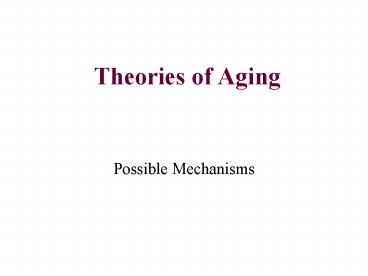Theories of Aging - PowerPoint PPT Presentation
1 / 21
Title:
Theories of Aging
Description:
Theories of Aging Possible Mechanisms 3 Criteria of Aging Theories Change in Structure / Function 3 Catagories of Theories Wear and Tear Theories Wear and Tear ... – PowerPoint PPT presentation
Number of Views:1033
Avg rating:3.0/5.0
Title: Theories of Aging
1
Theories of Aging
- Possible Mechanisms
2
3 Criteria of Aging Theories
1. Must occur in all individuals of the
population 2. Produce Changes in function/
structure 3. Changes increase with age
(progressive)
3
Change in Structure / Function
Cellular- previous lecture Acellular-
extracellular matrix ground substance fibers c
ollagen (up to 30 of protein) elastin
4
3 Catagories of Theories
1. Wear and Tear (Damage) Theory 2.
Physiological/ Chemical Changes 3. Genetically
Programmed (Senescence Genes)
5
Wear and Tear Theories
Weismann (1891) Ordinary insults and injuries of
daily living accumulate and decrease function to
some sub-vital level e.g. loss of teeth --gt
starvation molecular level enzymes accumulat
ion of harmful metabolites (cell garbage
theory) e.g. aldehydes, free radicals,
lipofuscins interfere with cell function
6
Wear and Tear Theories (cont.)
- finite energy theories
- animals with high metabolic
- rates have shorter life spans
- rats on calorie restrictive diets live longer
- mammals and birds should live shorter
- lives
- People that exercise should live
- shorter lives
7
Wear and Tear Theories Refuted
1. Animals in protected environs. have no
change in maximum life span. 2. Time-dependent
changes cannot initiate aging 3. Cellular/
Genetic evidence
Reformulated as Failure to Repair Theories
8
Physical/ Chemical Changes
1. Cross Linkage Theory (Post-translational
modification) macromolecules cross linked
(denatured) leading to a decline in
function e.g. proteins- collagen, elastin How
? Disulfide Bonds (cys-cys) Advanced Glycation
End-Products (AGEs) accelerated in
diabetics DNA cross-linkage occurs also
9
Physical/ Chemical Changes
2. Altered Protein Theory protein folding no
change in primary structure decline in catalytic
activity with age e.g. enolase in
nematodes denature/renature experiments shape
change can be reversed increased carbonyl
content (ketones, aldehydes) of proteins
(oxidative)
10
Physical/ Chemical Changes
3. Free Radical Theory (Oxidative Damage) Free
Radicals contain unpaired electrons making them
highly reactive therefore only exist for a
short time. e.g. Superoxide, hydroxyl ,
peroxide Lipid peroxidation- damage to cell
membranes especially mitochondrial Protein cross
linkage DNA damage Antioxidants - Vitamins A, C,
E, Cellular Defenses- Catalase, Superoxide
Dismutase
11
Reactive Oxygen Species
12
(No Transcript)
13
(No Transcript)
14
Aging By Program
Assumptions Biological Clock Molecular Clock-
the Telomere ? Life Span Inheritable Twin
Studies Biological Clock Hypothalamus Decline
in Signal Decreased Sensitivity to
Feedback Programmed senescence does not require
central control - cell culture evidence
15
(No Transcript)
16
(No Transcript)
17
(No Transcript)
18
Aging By Program
Gene Mutation Theory- accumulation of somatic
cell mutations leads to a decline in
function Liver cells of older mice have
more mutations than young Short life span
strains have more mutations at same age DNA
repair mechanisms Decrease in repair function??
19
Aging By Program
Gene Theory One or more harmful genes active
only later in life Evidence? Microarray
analysis Death Genes or Gerontogenes
20
Microarray Analysis C. elegans
21
Evolutionary Theories
Disposable Body Theory- Post-reproductive
individual has no benefit No genes favoring long
life-span should evolve Genes do not cause
aging, but fail to prevent it from
happening Antagonistic Pleiotropy Theory- Genes
that promote success at a young age have a
negative effect at old age Late-acting error
theory- errors occuring before reproduction
eliminated by natural selection no selective
pressure to eliminate them after

